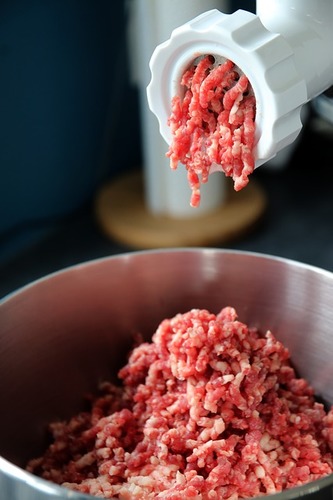Short answer
Regular ‘store brand’ ground beef is bad for you. Meat from a cow that is range (grass) fed and not treated with harmful antibiotics and hormones is a much better alternative and greatly reduces the adverse health effects.
Recommended Alternative
Long answer
The only “healthy” way to go is organically raised and vegetarian fed cattle. However, many Americans need convenient and cheap, and raising livestock the natural way does not fall into those two categories. We are so caught up in the fast and furious stages of mass production that beef cannot even be slaughtered the same way anymore; consumers buy thousands of pounds of ground beef daily, just to satisfy the fast food industry alone.
Concentrated animal feeding operations (CAFO’s) are where thousands of cattle are herded into a small space to be grown to their highest possible potential before being slaughtered. These herds are fed a combination of soy, wheat products and unknown by-products and proteins that are inoculated with growth hormones to increase the rate of growth and the amount of growth of the cattle. They are also fed GMO’s, which are all of the plants that are included in the animal feed. GMO crops are designed to be more resistant to disease and to the pesticides that are used to kill weeds and antigens in the soil. The GMO centered life cycle leaves the cattle with weakened immune systems, making them more susceptible to disease due to the genetically modified feed.
The presence of these artificial animal and plant growth additives have had devastating consequences to the culture of people involved. Every system in the human body can be affected, including the cardiovascular system, central nervous system (CNS), digestive system, endocrine system (hormones--especially in children), integumentary/exocrine (skin, hair, etc…), lymphatic system (immune health), muscular/skeletal system, renal system (kidneys), reproductive, and respiratory system.
Not only are cows more susceptible to catching diseases because of a weaker immune system, but also because they are kept in a small surface space, packed together, and standing in their own feces for hours before it is cleaned. Such unsanitary conditions breed bacterial and viral diseases that can be easily transferred from animal to animal because of their proximity.
Furthermore, there is an increased probability livestock is dead or dying from disease in the time leading up to their execution.
Due to rampant disease in the CAFO’s, antibiotics are given to the cattle, which in turn can cause resistant strains of bacteria. Treatment-resistant bacteria is then passed to the consumer via meat or milk, sometimes leaving the infected people with an untreatable disease or ‘hyper-bug’. E Coli and Salmonella are two of the most common cattle transmitted bacteria, having terrible symptoms, which include fever, body aches, dehydration, nausea, diarrhea, vomiting, and death.
The beef is also purchased as ground beef in mass quantities by numerous well-known fast food chains around the world. These large companies are constantly looking for ways to cut costs and raise their bottom line, which for the consumer means barely meeting health standards of how much real meat is used. Some fast food chains have been caught labeling a product as ‘beef’, containing less than 50% of actual beef.
A 2012 news article reported, “70% of the ground beef sold and bought in supermarkets contains pink slime”. Pink slime is made from the trimmings of cows that is deemed “unwanted” and are sprayed with ammonia to kill bacteria. According to the reports in the news article, pink slime is not real beef, but simply fat that has been processed and sprayed with harmful chemicals.
The United States Department of Agriculture (USDA) has approved pink slime for use as a filler in ground beef. This toxic waste substance is added to “improve taste” and increases the profit margins for the producer. In fact, pink slime and other fillers have been so widely used in the restaurant and fast food industry, these companies now have to meet “quality meat standards”. According to these standards, a certain percentage of their ground beef has to be real ground beef or the federal government can impose heavy fines on the meat processing company.
There are many dangers when it comes to eating ground beef. These dangers exist whether the meat prepared by the consumer, or it is prepared for the consumer by a restaurant. Cooking meat thoroughly is the best way to kill any bacteria that may exist in the ground beef. The safest and healthiest way to consume ground beef is using 100% beef that is organically raised and fed a diet that excludes harmful GMO’s, hormones, and antibiotics.
Possible short-term side effects
- e.coli poisoning
- salmonella poisoning
Possible long-term side effects
- hormonal imbalances
- antibiotic resistance
- heart disease
- high cholesterol
- diabetes
- obesity
- cancer
Ingredients to be aware of
- beef by-products
- pink slime
- soy
- vegetable protein product
- antibiotics
- hormones
- gmos

Healthier alternatives
- organically raised (grass fed) beef
Our Wellness Pick (what is this?)
Beyond Meat Plant-Based
- Vegan friendly
- Soy-free product
- No gluten content
- Convenient pack size
 Approved by
Approved by 






.png)





.png)


